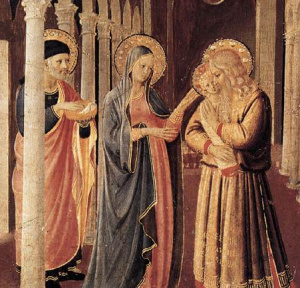The High Priest was a hereditary office in ancient Israel, usually held for life, that begun with Aaron, the older brother of Moses (Exodus 29:29 - 30, Leviticus 8:12, 16:32). He was anointed into the office of High Priest at the age of 83 in 1445 B.C. He died on Mount Hor, which lies on the western edge of the land settled by the Edomites, at the age of 123 (Numbers 33:39).
The role of the High Priest was to serve as an intermediary between God and his people (ancient Israel). He was considered the highest ranking spiritual leader among the Israelites. One of his unique responsibilities was to perform the tasks required on the Day of Atonement and sprinkle blood on the Ark of the Covenant.
The High Priest wore, unlike the other priests, unique vestments, such as a breastplate of precious gems designed by God. He also carried with him the Urim and Thummim. The High Priest was considered the presiding officer of the Sanhedrin, which met in Jerusalem.
Eleazar, Aaron's oldest surviving son at the time of his death, assumed his father's role as High Priest just as the Israelites were about to enter their inheritance in Canaan. He is noted as helping Joshua assign land to each of Israel's tribe after they entered Canaan (Numbers 34:17, Joshua 14:1). After his burial in the city of Gibeah (Joshua 24:33) his son Phinehas assumed his High Priest duties and responsibilities.

Phinehas, Israel's third high priest (Numbers 25:10 - 13), was greatly blessed by God (1Chronicles 9:20). Because he killed a defiant Zimri and stopped a plague (Numbers 25:1 - 9) God promised that his descendants would serve as he did as well (verses 10 -13). His son Abishua served upon his death. Very little is known about Abishua apart from a few scant Biblical references (1Chronicles 6:4 - 5, 50, Ezra 7:5). Abishua's son Bukki serves next then Uzzi.
The High Priests from Uzzi to Eli and beyond is somewhat open to debate. There is no single place in the Bible that gives a comprehensive listing of these important individuals. What is known is that the priestly line continued through the descendants of Eleazar until it transferred to the line of Ithamar through the person of Eli. He not only served as head of the priests (1Samuel 1:9) but was also a Judge of Israel.
During Eli's service he named his two sons, Phinehas II and Hophni, to serve jointly has head priests (1Samuel 1:3). They became so corrupt, however, that God caused them to die during a battle on the same day (1Samuel 2:27 - 36). After their death the priesthood went to Ahitub, Eli's grandson. It then went to Ahimelech (Ahiah).
Ahimelech was High Priest during the time when King Saul was trying to kill David (1Samuel 21:1). He was executed by order of Saul (1Samuel 22:16 - 19) for befriending David. Ahimelech's son Abiathar escaped Saul's bloody purge at Nob and fled to David (1Samuel 22:20 - 23). Abiathar eventually became the top Priest.
When Solomon came to power he removed Abiathar from being High Priest (1Kings 2:26 - 27) and made Zadok the sole person to fill the position. After Zadok' death came Shallum, Hilkiah, Azariah, Seraiah (2Kings 25:18) and Jehozadak (1Chronicles 6:14 - 15). After Jehozadak' service was Joshua (Haggai 1:1, 12, 14), Joiakim (Nehemiah 12:10), Eliashib (Nehemiah 3:1), Joiada (Nehemiah 12:10), Jonathan (verse 11) and Jaddua (verses 11, 22). After Jaddua, the Bible is silent regarding who help this spiritual position in Israel until the time of the New Testament.